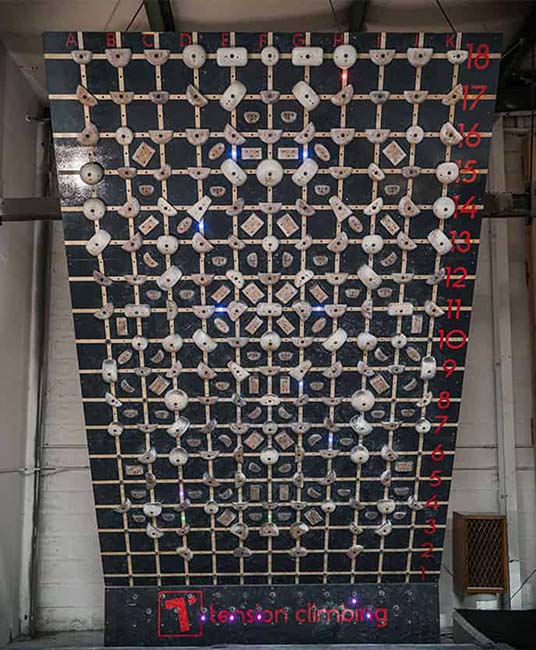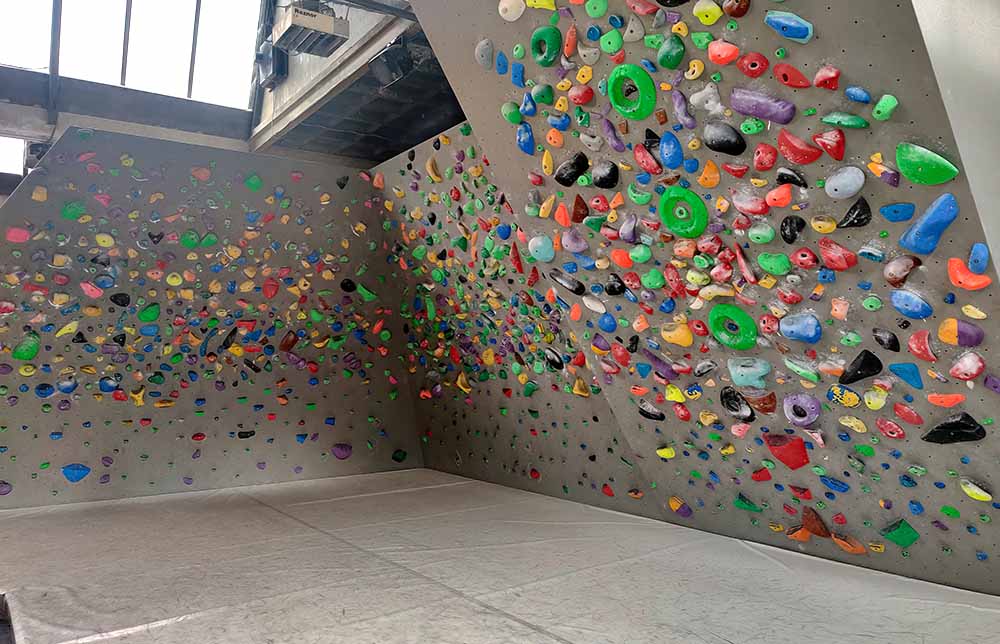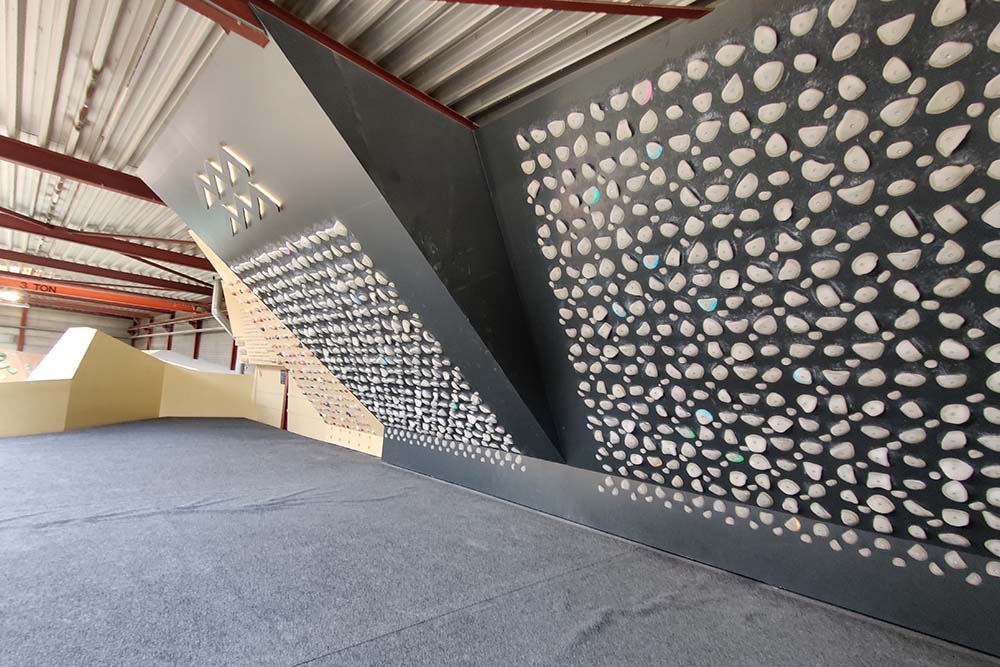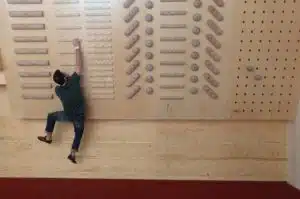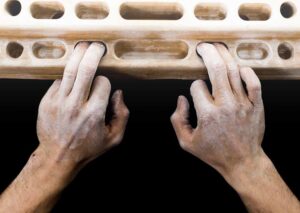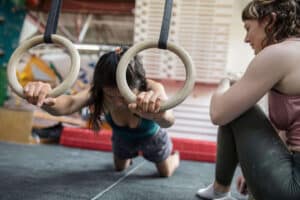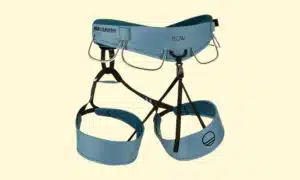The key to mastering a rock route, be it in a climbing gym or the rock outside, lies in a blend of power, stamina, and technique. Climbing isn’t just about pulling yourself up the wall; it’s a dance of strength, technique, and mental fortitude.
You can develop this simply by climbing a lot, and many climbers never touch specific training. But once you move into harder climbs, particularly sport and boulder routes, you may find yourself plateauing, and needing to focus on specific aspects of your skillset.
Here, I’ll share four example workouts that target crucial aspects of a climber’s arsenal: power endurance, finger strength, overall endurance, and dynamic movement.
Let’s discuss the tools we’ll use, such as Tension Boards, systems boards, spray walls, and Kilter Boards, and then move into some specific workouts.
What are Tension Boards? Tools for Tension Strength
Power and endurance are the cornerstone of a climber’s ability to execute hard moves consistently over a climb. Learning to sesh Tension Boards can be a game-changer for this. But what’s a Tension Board? Well, Tension is a specific brand that makes these boards, but the term is often used incorrectly to refer to similar tools (MoonBoard or Kilter Board are others, for example).
In general, when people talk about a Tension Board they’re referring to Tension’s 8′ by 12′ symmetrically-set training board, installed at a steep angle (45 degrees at most). Some Tension Boards are installed at a fixed angle, while others are adjustable, allowing climbers to change the angle to suit their training needs. Tension Boards, in particular, are made with Tension’s unique wooden holds.
Unlike traditional symmetrical boards (called systems boards), Tension Boards don’t just allow the execution of mirrored, isolated movements, but entire miniature boulder problems.
The beauty of this training tool lies in its ability to present endless possibilities of routes, from smaller holds to larger holds, requiring both finger strength and body tension. It’s also much more fun to work a Tension Board than many other training tools because it adds the creativity and variety of a typical climbing route into a targeted workout.
For climbers, the key on Tension Boards is to focus on problems that challenge your current ability, increasing difficulty only gradually. Begin with a warm-up on big holds (ideally on steep or low-angle terrain), then move to the board and tackle smaller, more challenging ones. The goal is to mimic the same move or sequence repeatedly, building muscle memory and endurance. Aim for 3 to 9 sets, depending on your current level of training.
Though they’re great tools for power and endurance in general, Tension Boards are better for developing tension strength than raw explosive power. For that, try a Kilter Board (below).
System Board Climbing? Your Ticket to Precision and Strength
The system board is a non-brand-specific training board for developing pure finger strength and power. Unlike the dynamic moves you’d find on a bouldering wall, system board climbing demands precision and a fixed angle, which helps in building specific strength.
System boards feature symmetrically set holds, similar to most fingerboards. This symmetry allows climbers to perform the same movements on both sides of their body, promoting balanced muscle development and reducing the risk of injury caused by muscle imbalances.
Though systems boards are symmetrical, they include a variety of hold types, such as crimps, pinches, slopers, and pockets. Like Tension Boards, they can be fixed at one angle, or adjustable. By using a system board, climbers can identify and work on their weaknesses.
For instance, if a climber struggles with crimp holds, they can use the system board to specifically train and improve their crimp strength and technique on both sides.
The consistent layout of a system board also makes it easier to measure progress over time. As you get stronger, you can complete more difficult movements or sequences, or perform the same exercises with more ease.
Spray Walls? No, We’re Not Talking about Spraying Beta
Spray walls, a staple in most climbing gyms, offer a multitude of holds set at various angles, allowing climbers to create their own problems and simulate longer routes. They’re essentially mini bouldering walls, with holds of all shapes and sizes arrayed at all angles and positions. Spray walls are set at a steep angle, from 30 to 45 degrees.
The key to effective spray wall training is variety. Mix in sessions focusing on endurance, where you climb at a moderate difficulty for an extended period, with others that emphasize power, featuring harder moves on smaller holds.
Spray wall training is more fluid and loose than working on a system board or Tension Board. A typical spray wall session could involve climbing a set number of problems without rest, then taking a break before tackling another set.
Kilter Training Board: Explosive Power
A Kilter Board is quite similar to a Tension Board (and some people erroneously refer to the two as each other) but they have a few differences. The original Kilter Board has over 300 unique holds (far more than the 200 that come with the original Tension Board).
Kilter Boards are also designed to be extremely overhung if need be (up to a whopping 70 degrees). They are much easier to adjust in terms of angle than Tension Boards and feature more welcoming holds, making them more viable for beginners. Kilter Boards come in a variety of sizes, but the original measures 12’ by 12’.
With its adjustable angle and hold set, Kilter Boards bring an element of fun and challenge to board training, and makes it much more accessible for beginners, allowing you to work the same sequence at progressively steeper angles to develop additional power.
These boards can be set as mellow as 5 degrees, making it even possible to train slab-style footwork on them. It’s a fantastic tool for climbers to practice specific angles and types of holds, crucial for outdoor climbing experiences.
Four Training Board Workout Examples
Tension Board Climbing: Tension and Endurance
Workout Objective
Improve power endurance through repetitive hard moves.
- Warm-Up (15 minutes):
- Start with easy climbing on big holds to engage your upper body, fingers, and core.
- Incorporate dynamic stretching to enhance flexibility.
- Remember, a good warm-up prepares your muscles and mind, reducing the risk of injury.
- Main Set (45 minutes):
- Select a challenging route on the Tension Board. This should be hard but doable, emphasizing small holds and power moves.
- Climb the route, then rest for the same amount of time it took to climb. Repeat this 5 times.
- Increase the route’s difficulty slightly, and repeat the 5 climbs with equal rest.
- Focus on maintaining form and precision throughout.
- Cool Down (10 minutes):
- Gentle climbing on larger holds.
- Stretch focusing on the upper body and fingers.
System Board Training: Target Technique and Strength
Workout Objective
Build specific strength and power, especially in fingers and forearms.
- Warm-Up (10-15 minutes):
- Light bouldering or climbing on easy routes.
- Wrist and finger stretches.
- Strength Circuit (30-40 minutes):
- Select 4-6 boulder problems that emphasize different grips (crimps, slopers, pinches).
- Perform each problem 3 times with a 3-minute rest in between.
- Use a mirror image approach: for every problem done with one hand leading, do a reverse with the other hand leading.
- Cool Down (10 minutes):
- Easy climbing or traversing.
- Full-body stretching with an emphasis on the upper body.
Your Climbing Gym’s Spray Wall: Ticket to Creativity
Workout Objective
Enhance climbing endurance and route-finding, and refine technique.
- Warm-Up (15 minutes):
- Light jogging or jumping jacks to raise heart rate.
- Easy climbing traverses.
- Endurance Sets (60 minutes):
- Choose a series of moderate-difficulty routes on the spray wall.
- Climb continuously for 10 minutes, then rest for 5 minutes.
- Repeat this cycle 3-4 times, aiming to maintain a steady pace without sacrificing technique.
- Incorporate different types of moves and grips to mimic outdoor conditions.
- Cool Down (10 minutes):
- Light traversing or climbing on easy routes.
- Stretch, focusing on the shoulders, arms, and fingers.
Kilter Board: Building Stamina, Power, and Interval Training
Workout Objective
Combine power and precision in a fun, engaging session that breaks things up a bit.
- Warm-Up (10 minutes):
- Cardio exercises like jumping rope or high knees.
- Light climbing on easy routes for upper body activation.
- Power Intervals (50 minutes):
- Select 5-6 challenging routes on the Kilter Board.
- Climb each route, then rest for double the time it took to climb.
- Repeat each route 2-3 times with a focus on executing dynamic moves and maintaining body tension.
- Play with the board angle to simulate different climbing scenarios.
- Cool Down (10 minutes):
- Easy bouldering or climbing.
- Comprehensive stretching, with an emphasis on the back and arms.
Remember to always listen to your body, rest adequately, stretch, and stay hydrated to maximize the benefits of your training.
Frequently Asked Questions
Climbing training is as diverse as the sport itself. Here, I’ll answer some of the most frequently asked questions, drawing from my extensive experience in the climbing world.
How often should I train for climbing?
The frequency of your training depends on your experience level, goals, and overall fitness. For beginners, climbing 2-3 times a week allows for sufficient recovery while building strength and technique.
More experienced climbers might train 3-5 times a week, incorporating specific workouts for strength, endurance, and technique. Rest days are crucial for muscle recovery and injury prevention.
What are the key focus areas in climbing gym training?
- Finger Strength: Crucial for gripping holds. Exercises like hangboarding and system board training are effective.
- Endurance: Both short-term power endurance and long-term endurance for longer routes. Interval training on climbing walls can help.
- Technique: Includes footwork, body positioning, and efficient movement. Practice on varied routes and terrains.
- Flexibility: Improves range of motion and helps in reaching difficult holds. Incorporate regular stretching into your routine.
- Mental Training: Climbing is as much mental as it is physical. Practice visualization and stress management techniques.
Is cross-training beneficial for climbers?
Yes, cross-training can be highly beneficial. It helps in overall fitness, reduces the risk of injury, and can improve climbing performance. Activities like yoga, swimming, and cycling are excellent for developing the cardiovascular health, flexibility, and muscle endurance used in climbing without over-stressing climbing-specific muscles, making them viable on non-climbing days.
What kind of diet should I follow as a climber?
Good diet is key. Focus on protein for muscle repair and recovery, complex carbohydrates and whole grains for energy, and healthy fats for overall health. Lots of fruits and vegetables are important, as is hydration.
Supplements like collagen are popular among climbers because they promote joint, ligament, and tendon health, which is a common cause of climbing injury. In general though, there is no climbing specific diet. Just follow the same balanced, healthy diet that you’d follow if you were engaging in any other athletic endeavor.
How do I avoid injuries while climbing?
To avoid injuries make sure you warm-up consistently, listen to any pain or discomfort and stop climbing if you feel it, learn and use proper technique (reducing strain on any single muscle group), and work to strengthen supporting muscles like your core, shoulders, and hips. In addition, be sure to rest adequately. Overtraining is a common cause of climbing injury.
Can I train for climbing at home?
Yes, there are various ways to train at home. These include:
- Hangboard Workouts: On off days or times when you can’t make it to the gym, a home hangboard routine will keep your finger strength up.
- Bodyweight Exercises: Examples are push-ups, squats, planks, dips, hangs, and pull-ups. These improve all-around fitness and strength-to-mass ratio.
- Yoga and Stretching: A critical part of home training, yoga will keep you limber and flexible.
How long does it take to see improvements in climbing?
Improvement timelines vary. Beginners might see rapid progress even from basic climbing, while experienced climbers often experience more gradual improvements. Consistent training, proper nutrition, and adequate rest are key. Typically, noticeable improvements will be seen after a six months of dedicated training.
Conclusion: Slow and Steady Wins the Race
Incorporating workouts like these into your training regimen can significantly impact your climbing ability. Remember, the focus is gradual progression, listening to your body, and maintaining a balance between power and endurance.
Climbing is not just about reaching the top; it’s about the challenges of individual moves, learning new techniques, and enjoying yourself on and off the wall, regardless of how hard you send.


